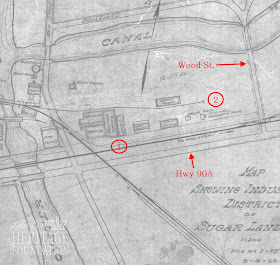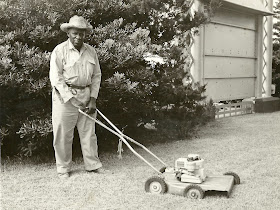This is the last in my series of posts about cotton, which is still a major crop in Fort Bend County, but not so much in its eastern half. Until roughly 40 or 45 years ago, raising cotton was a significant part of Sugarland Industries, but once its land was sold off and the corporation dissolved, cotton was no longer part of our community.
Someone will have to help me with this, but the cotton gin (see images below) was shut down several years before the Industries dissolved. I don't have a clue about the precise date.
The following article appeared in the August 15, 1925 issue of the Texas Commercial News, Sugar Land's local paper at the time. The article goes into detail about the crop, the gin, and the condition of the '25 harvest.
Sugar Land's gin was located where the east end of Nalco's plant stands today (where Ulrich St. meets the railroad tracks).
The first two photos are blow ups from the third, which shows the gin in the 1920s. Note the mules and wagons. I assume the large sacks are filled with seed. (See the article above about processing cotton seed.)
The next photo was taken a few years later, I think. (There are no dates on any of these photographs.) As best I can tell, the hexagonal building on the right with the cupola doesn't appear in the earlier photo.
I've posted the next image before, but I've used it again to give an additional perspective of the gin. (This image is also undated, but it's probably a scene before the '20s.) The wagons in the foreground are parked in front of old The Red Barn Cafe's location a few decades later. I've magnified the photo for close inspection, and I can't see any indication of a crossing where Ulrich St. should be. If you looked closely at the previous post showing the 1928 map of Sugar Land, you saw Ulrich St. clearly marked, so this photo must be earlier than 1928.

This last photo is obviously modern, and it shows the gin in Crosbyton, east of Lubbock. I've included it because it contrasts a modern gin with the one shown in the images below. Those are cotton modules, which I've discussed in earlier posts, lined up beside the gin. They may be hard to see, but in the distance on the right you can see two module haulers. They look like boxcars. One is tilted upward. They are the modern version of the wagons you see in the image immediately above.































